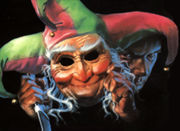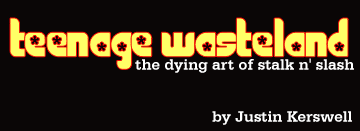

 |
 |
"There's more than one way to loose your heart!" - MY BLOODY VALENTINE (1981)"John will never eat shish kebab again!" - HAPPY BIRTHDAY TO ME (1981)
"It's not human... and it's got an axe!" - THE PREY (1980)
...if you are anything like me, the above taglines, from early 80's slasher movies, will fill you with a warm sense of nostalgia; rather than the camp terror they were designed to induce. And without meaning to descend into sappy sentimentality, I can't help but recall my yearning, stolen glances at the poster for FRIDAY THE 13TH: PART 2 (1981)- the one with the silhouette of Jason holding the bloody axe, as my school bus passed by the local Odeon. Nor can I help indulge in a bit of moist eyed reminiscing ( the kind usually reserved for a dear long departed pet), for the illicit afternoon spent in front of the television, as a monolithic Betamax VCR whirred; transfixed by the dubious pleasures of HALLOWEEN II (1981)- the first 'X' rated horror film I ever saw!In the intervening years, between then and now, my taste for the genre has broadened considerably- embracing everything, from Val Lewton, to Walerian Borowcyk, to the low-fi terrors of THE BLAIR WITCH PROJECT; but I
always come back to my first love- the slasher movie. The reasons why I continue to be seduced by its cheesy charms, and why I've dedicated a whole website to them (HYSTERIA!- which you can (plug!, plug!) find at: www.south-over.demon.co.uk/ ),are legion. Alan Jones, in his excellent NEKROFILE: CINEMA OF THE EXTREME, said of the FRIDAY THE 13TH series, "I adore [them]... I love their stripped-to-basics formula splatter approach with the odd twist here, and the strange quirk there, to keep the addicted NEKROFILE on their toes. I get off on the lethal predictability almost... You go in knowing you'll see nothing new, yet that's all part of their charm. Comfort Horror."; and I guess that goes part of the way to explaining why I'll always get a kick out of watching movies which, as Neve Campbell puts it in SCREAM (1996) "[feature] some stupid killer stalking some big breasted girl, who can't act, who's always running up the stairs when she should be going out the front door."
"You gotta see the dress I got. Cut down to there, split up to here. I may not get out alive!"
- sadly prophetic words for a teen gearing up for Valentine Bluff's first Valentines dance in 20 years, from MY BLOODY VALENTINE (1981)
The film which initiated the cycle of slasher movies which dominated the horror genre in the early 80's, was John Carpenter's box-office smash HALLOWEEN (1978); the story of the night "HE came home". Combining many elements (including the soon to become famous opening tracking shot of the house), from BLACK CHRISTMAS (1974); utilising the lean shock tactics of Dario Argento's gialli; and using the blank faced killer from Mario Bava's BLOOD AND BLACK LACE (1964), as the inspiration for his murderous 'shape'- Michael Myers; Carpenter crafted a sublime chiller. It was a hit with the critics; Richard Combs in the February 1979 issue of the 'BFI Monthly Film Bulletin' called it, "...one of the cinema's most perfectly engineered devices for saying 'Boo'!" It is a flawlessly stream-lined thriller, stripped of narrative flab it proved the old axiom that, especially in this case, less was definitely more. However, eager for a repeat of the film's box-office gold, the 'cookie-cutter' imitations soon started to appear (including a cheeky Australian entry originally called SNAPSHOT (1979), which changed its title to DAY AFTER HALLOWEEN; fooling some people into thinking it was an official sequel!). Carpenter's film was easily imitated, but never bettered. Film makers were quick to realise that nothing more could be stripped away from its lean formula, so subsequently they went the other way- expanding the film's more exploitative aspects, upping the ante with extra gore and t&a; and adding superfluous plot. Critical reaction to them quickly cooled. Paradoxically, as American cinema became ever more explicitly violent, the media and pressure groups began to question the effect this was having on society. There began a process of demonisation; violent films, and at the time the majority of violent films were slasher movies, were blamed for an array of ills. By the time FRIDAY THE
13TH (1980) (which was a loose remake of Mario Bava's BLOOD BATH (1971)), hit our screens the critical response was downright hostile. After much outrage in the States that such a violent movie had been passed with an R-rating, the influential critics Gene Siskel and Roger Ebert seethed, "These movies are absolutely beneath contempt." They promptly initiated a campaign to ruin the film's box-office by, firstly, giving away the film's ending; then suggesting a letter campaign against Paramount Pictures for lowering themselves to handling such a picture; and starting a similar one against Betsy Palmer, who could normally found in has-been heaven on Celebrity Squares, for daring to play the homicidal Mrs Voorhees. They failed in their attempts to ruin the film; it did boffo box office. Paradoxically, here in England, then head of the BBFC- James Ferman, was in an uncharacteristically generous mood; explaining why he let the film through unscathed he said, "The murders were so far fetched, with knife blades coming up through beds into somebody, that it was clearly unreal." Then adding, "The nice thing about fantasy is all the time you can keep reminding yourself, "I can't get hurt, no one's going to get hurt, it's just make believe."" But although Siskel and Ebert lost the battle, they pretty much won the war; the MPAA (the US film classification board) took such a rap on the knuckles over FRIDAY THE 13TH, that most subsequent slasher movies had to loose a great deal of their gory mayhem to secure an R-rating; and it was the FRIDAY THE 13TH movies, beginning with the first sequel, which were treated most severely. In turn it was generally these truncated, anaemic versions that made it to the UK; and thus there wasn't much left for the BBFC to cut out (not that, that stopped them trying when it came to home video a few years later!) The slasher movie was, by this point, regularly referred to as the absolute nadir of the genre by critics and a good deal of horror enthusiasts alike; and although they continued to make money, the rot had set in. The majority of them were critically mauled; in the September 1981 issue of 'Films on Screen and Video', Eric Braun, during an emotive (for all the wrong reasons) review of HAPPY BIRTHDAY TO ME, states, that film and others of its ilk were (somewhat improbably), responsible for the decline in British cinemagoing; he whined: "The systematic killing, unhappily, seems to extend to the cinemas on Rank's doomed list, which are being quite inevitably emptied by a constant diet of this kind of nonsense... Please mourn with me the unhappy demise of many splendid halls of entertainment." By 1982, the sub-genre seemed to be dead in the water- certainly as far a major studio financed slasher movies went; and apart the increasingly dry FRIDAY movies, the mad slashers had to relegate their sordid activities to a different medium- the emerging phenomenon of home video.
The sub-genre found a whole new life-blood with the boom of this new technology; and in the case of the 1981 slasher THE BURNING, quite literally so, as THORN EMI accidentally released the film uncut in October 1982 (much to the their eventual embarrassment); complete with the 15 seconds that the BBFC removed to qualify for
its 'X'-rated cinema run. It seemed for a while that the gore-slasher movie hybrid might be having the last laugh. Free from the BBFC's meddling censorship it flourished, sharing the limelight with the even less reputable Nazi and Cannibal sub-genres, as horror took over from porn as the biggest money maker in video's pioneer days. Most of the bigger budget, studio made slasher movies appeared on video in their tame cut versions, but the smaller, fly-by-night outfits released low budget efforts that by-passed British cinemas (and hence BBFC censorship)- films like PRANKS (1981) (which is better known in the US as THE DORM THAT DRIPPED BLOOD); or beefed them up, doing on purpose what THORN EMI had done accidentally- Romano Scavolini's visceral NIGHTMARES IN A DAMAGED BRAIN (1981), being a good example; David Hamilton Grant, the film's UK distributor, infamously reinstated the 60 seconds the BBFC cut for its theatrical run and got a six month prison sentence as thanks when the film was successfully prosecuted on obscenity charges. The brief respite for the slasher movie came to a sensationalised end as many of the movies were yanked from video stores up and down the country; as the media and politically fuelled 'video-nasty' hysteria took hold. By 1984 mainstream cinema was comparatively free of the slasher movie, all apart from the fourth FRIDAY THE 13TH, which was ostensibly the series' parting shot. The sub-genre that had stubbornly refused to die, finally seemed to breathe its last with the release of a irredeemably misanthropic, redundant piece of zero-talent trash called SPLATTER UNIVERSITY (1984)- the moment when the slasher movie really reached its true nadir; and the cycle which had lasted from 1978 to 1984 pretty much petered out.
 |
 |